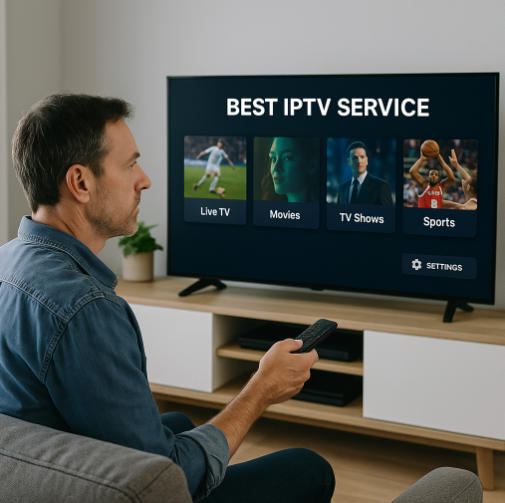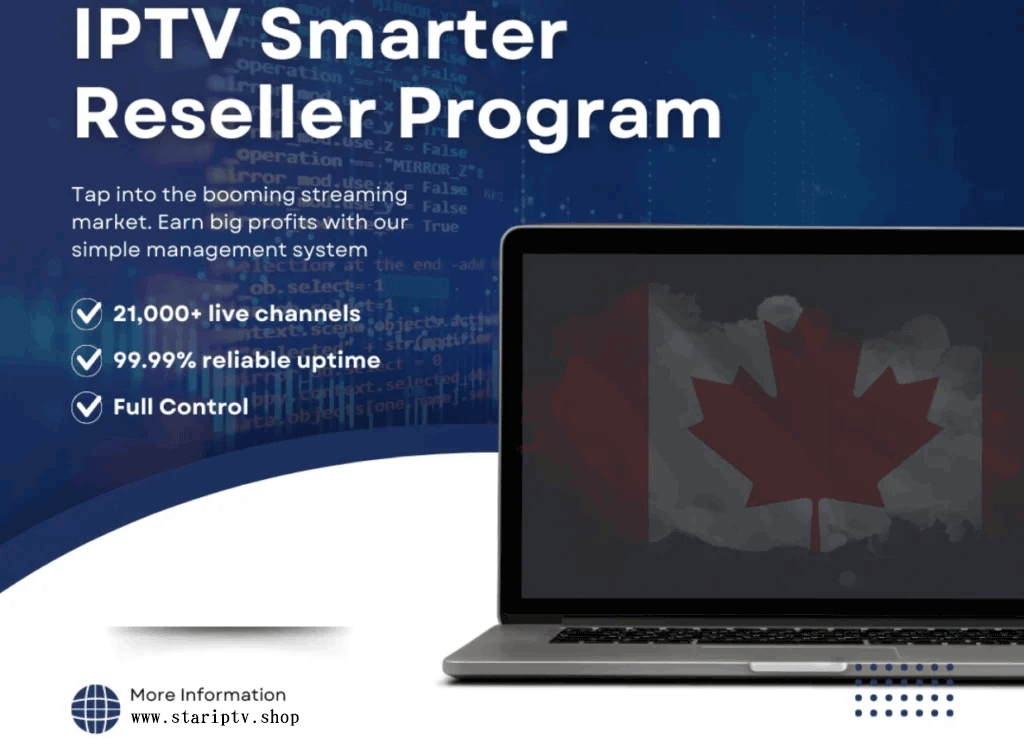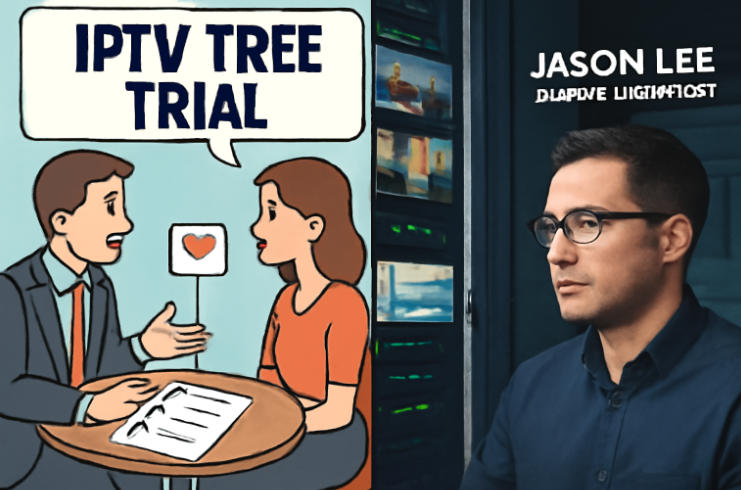Finding the best IPTV service in 2025 isn’t just about flashy features or slick apps—it’s about making sure your bulk setup won’t crack under pressure. Aussie businesses aren’t after fluff; they want IPTV that just works, streams sharp, and keeps clients happy without charging like a wounded bull.
Take Mick, who manages 20 serviced apartments in Sydney. His old provider dropped channels mid-tour. “We needed a fix that didn’t make us babysit the tech,” he said. That’s when he switched to a setup with 4K sports, on-demand TV, and smooth remote control—problem solved, guests stoked.
This guide covers what matters most: how to pick a provider that won’t ghost you, what features save you dollars long-term, and how to dodge region-specific headaches—especially if you're doing business across states or overseas.
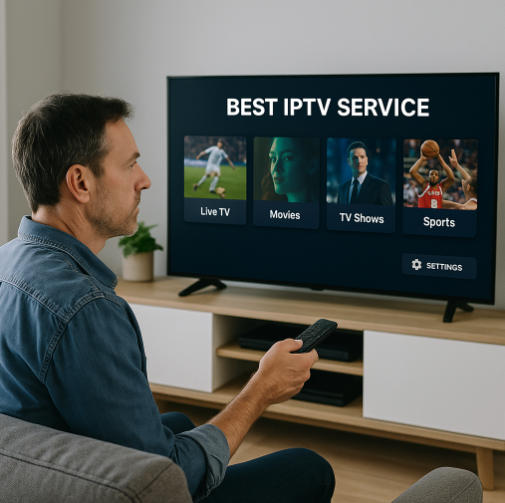
As Star IPTV’s Head of Product, Erin Collins, puts it: “You don’t need 100 features. You need five that work every time.” If you want to see how we package those five, browse our IPTV subscription options and enterprise tiers.
If you're buying big, this is the kind of no-nonsense info that helps you stop guessing and start streaming right.
5 key factors to choose best IPTV provider
This section walks you through the 5 most important things that matter when picking an IPTV provider—especially if you're buying in bulk.
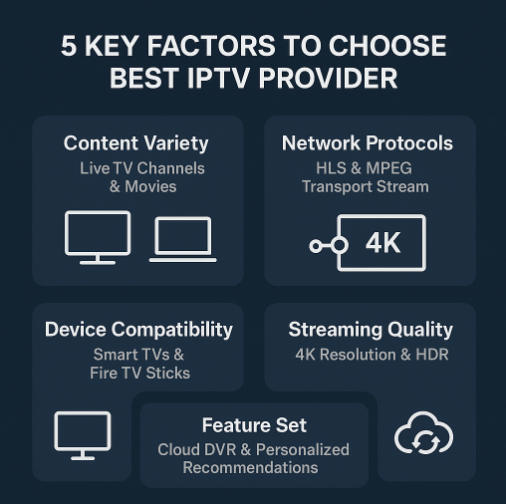
Content Variety: Live TV Channels & Movies
Make sure your provider isn’t skimping on content variety. It’s not just about the number of channels—they should also offer:
Reliable live TV feeds for sports, news, and entertainment
Access to a wide range of movies and on-demand series
Strong support for regional or niche content
Wholesalers often need to cater to different audience groups. A package with just sports or movies won’t cut it anymore. Your ideal IPTV partner should have content that satisfies binge-watchers, kids, and news junkies alike. If you need to test breadth before committing, grab an IPTV free trial.
Device Compatibility: Smart TVs & Fire TV Sticks
If your customers can’t stream on their favorite devices, the service won’t stick. Here’s what you should expect:
Full compatibility with Smart TVs, Fire TV Sticks, Roku, Android TV, and Apple TV—for example, Roku supports HLS and DASH playback, while Android’s ExoPlayer supports HLS and DASH. RokuAndroid DevelopersAndroid Git
Seamless playback on mobile and tablet devices
Quick app installation or easy integration with native OS platforms
Wholesalers should aim for providers that reduce technical headaches. The more plug-and-play the setup, the fewer complaints you’ll get from end users. For rollout steps and supported apps, see our IPTV setup guide.
Network Protocols: HLS & MPEG Transport Stream
A great IPTV experience depends heavily on how content is delivered over the internet. Watch out for these tech specs:
HLS (HTTP Live Streaming): Best for adaptive bitrate streaming and broad device support (Apple’s spec is the reference). Apple Developer
MPEG-TS: Ideal for smoother live broadcast experiences with less latency in broadcast-style delivery; it’s the system layer of MPEG-2 used widely for transmission.
If a provider can switch dynamically between protocols or customize delivery based on bandwidth, that’s gold. These choices seriously affect stream stability—especially during peak hours or live sports events. For adaptive streaming over HTTP, MPEG-DASH is also common in modern stacks.
Streaming Quality: 4K Resolution & HDR
You can have all the content in the world, but if it looks like it’s from 2005, it won’t hold up. Here’s what bulk buyers need to care about:
4K resolution support for ultra-clear visuals, especially on large-format displays.
HDR capabilities, which make a massive difference in color depth and contrast—formats like Dolby Vision are designed to optimize brightness, color, and contrast dynamically. dolby.com
Minimal compression, which keeps the stream crisp and not grainy.
Support for both HD and Ultra HD ensures flexibility for different clients with different screen types.
Quality sells. If your offering includes high-end resolution and beautiful visuals, it positions your brand as premium—instantly.
Feature Set: Cloud DVR & Personalized Recommendations
Don’t overlook the power of features. They can make or break the viewing experience. Look for IPTV providers that include:
Cloud DVR with reliable storage timeframes and easy retrieval
Personalized recommendations powered by smart algorithms
Access to catch-up TV, multi-screen viewing, and parental controls
Customizable user profiles for households or enterprise clients
The more tailored and flexible the features, the more your bulk buyers can upsell or bundle the service. For a breakdown of how we package features into reseller-friendly bundles, check Bulk buyers IPTV.
Pricing tiers and package options
A breakdown of IPTV plans helps buyers match the right service tier to user needs—from budget-conscious basic setups to premium deployments that demand 4K clarity and extra features.
Entry-Level Plans: Standard Definition & HD Streaming
These plans are perfect if you’re looking to serve cost-sensitive markets like rural lodges, schools, or second-tier hotels.
Usually includes:
SD streaming (480p)
HD streaming (720p) on selected channels
Limited multi-device access
It’s a budget option, not a compromise. Most users who just want news, local channels, and some kids programming won’t even notice the missing frills.
Ideal for regions with lower internet bandwidth, such as parts of South America or Africa.
These plans often cost 60–70% less than mid-tier plans and are widely used in entry-level hospitality setups.
Mid-Tier Plans: 1080p & 720p Options
Looking for a balanced option? Mid-tier plans are your best bet. Here’s how to think about them:
Assess your content mix – If your audience consumes a lot of TV shows, sports events, or documentaries, 1080p will enhance experience.
Match resolution with devices – Great for Smart TVs, tablets, and streaming devices in mid-scale deployments.
Check regional delivery constraints – For example, 720p fallback might be needed in areas with unstable internet.
Calculate ROI – These intermediate plans are cost-effective yet professional, with a per-subscriber cost 40% lower than premium tiers.
Roll out in tiers – Offer tiered subscriptions to customers (standard & plus), and upsell UHD later.
This is the popular choice among service resellers and mid-sized hospitality groups.
Premium Plans: Ultra High Definition & Dolby Vision
Streaming Quality
4K resolution & HDR content deliver immersive clarity.
Dolby Vision enhances contrast for sports and action content.
Device Ecosystem
Optimized for high-end Smart TVs, gaming consoles, and set-top boxes.
Needs strong network infrastructure—often fiber-based.
Content Value
Includes full suites of live TV, sports events, and music channels in UHD.
Often bundles multi-language feeds and region-specific broadcasts.
Target Use Cases
High-income audiences, boutique service models, and cinema-quality streaming environments.
When branding matters and image is everything—go premium. If you need contract-ready pricing for this tier, check IPTV subscription and reach out for enterprise quotes.
Add-On Options: Offline Downloads & Catch-Up TV
Add-ons are the icing on the cake—they give your IPTV offering flexibility and personal appeal that customers love.
Offline Downloads
Enables smartphone and tablet users to download shows/movies on the go.
A must-have in regions with patchy connectivity (Asia, rural U.S.).
Catch-Up TV
Ideal for live TV channels and news programs.
Users can rewatch missed content within 24–72 hours.
Boosts retention in time-zone-diverse deployments.
Other Add-On Features
Multi-screen profiles
Enhanced parental controls
Extra channel packs (kids, music, documentaries)
These features are key to boosting ARPU (average revenue per user) in bulk resale models—you can upsell them later as modular perks. For trial-based upsells, see IPTV free trial.
6 must-have features in IPTV plans
These features are no longer “nice to have” — they’re table stakes. If your IPTV service is missing any of them, you’re leaving money on the table.
Electronic Program Guide for Easy Navigation
An EPG isn’t just a glorified TV guide—it’s the control panel your users rely on.
Step 1: Integrate a real-time channel lineup that syncs with the provider's backend.
Step 2: Display accurate showtimes and listings with auto-refresh to avoid lags.
Step 3: Offer keyword-based search within the program schedule.
Step 4: Add navigation-friendly shortcuts for frequently watched channels.
Step 5: Include color-coded genre tags to improve visual clarity.
Fun fact: 68% of users drop off within the first 3 minutes if they can’t find what they want. The EPG is where you either win or lose them. (For background on EPGs and how they’re implemented, see Electronic program guide.)
Video on Demand for Movies & TV Shows
VOD isn’t optional—it’s where your users spend the bulk of their screen time.
Many bulk IPTV buyers want deep content libraries—TV series, blockbuster movies, and niche on-demand content.
A slick interface that encourages binge-watching can turn a casual viewer into a loyal subscriber.
Content sorting matters: genre, popularity, and recently added filters improve discovery.
Client Success Table
| Feature Set | Impact on Retention | Popular Genre | Monthly Engagement |
|---|---|---|---|
| VOD Library | +42% | Action/Drama | 14.7 hrs/user |
| Personalized Picks | +27% | Comedy/Romance | 9.3 hrs/user |
| On-Demand Movies | +18% | Thriller/Horror | 7.1 hrs/user |
Use data to shape your entertainment package. It's more than offering "more"—it’s about offering the right kind of "more."
Catch-Up TV for News Programs & Documentaries
Time-shifting isn't just convenient—it's crucial for viewers with busy lives.
Let’s be honest: not everyone watches the news live anymore.
Catch-up TV gives viewers the power to replay missed shows or rewind their favorite documentaries.
Smart replay controls like 24-hour or 7-day archives make a huge difference.
Combine that with time-shift navigation so users aren’t stuck watching an entire broadcast to get what they need.
"Catch-up functionality is one of the fastest-growing demands among hotel IPTV clients," says Clara Jennings, Senior Product Manager at Star IPTV, citing an internal study that showed a 32% usage spike for replay features in 2024. If you’re exploring this, our IPTV streaming FAQ explains typical catch-up windows and device support.
Multi-Screen Viewing on Smartphones & Tablets
Multi-screen equals multi-engagement. People want to stream wherever life takes them.
Customers love flexibility. On the sofa, in the kitchen, commuting—they want their mobile viewing seamless.
Your IPTV service must work across smartphones, tablets, and streaming devices with zero lag.
Consistent cross-device playback, like resuming a paused movie from TV to tablet, builds stickiness.
Use adaptive bitrates for smoother playback across bandwidth levels—protocols like HLS and MPEG-DASH enable ABR for fluctuating networks.
Prioritize fast app startup time—nothing kills mobile experience faster than buffering.
Parental Controls for Kids Programming
For bulk buyers catering to families, safety sells.
You need PIN-protected parental controls that are easy to activate and hard to bypass.
Set age restrictions, content filtering, and enable profile-level control for different age groups.
Offer family-friendly kids programming to complement the controls—security only works if there's good content to keep them occupied.
A family IPTV package without controls is like giving your kid the remote to a Formula 1 car. Keep it safe, keep it smart.
Personalized Recommendations for Music Channels
Music’s not just filler—it’s a lifestyle thing. Help users find their vibe.
AI-driven personalized recommendations keep your users discovering new music channels that actually fit their taste.
Think curated playlists, genre-based discovery, and user preference modeling.
Sync user history across devices so that the same tailored experience follows them from mobile to desktop.
When content fits the listener like a glove, churn drops like a rock.
How regional regulations shape growth in North America
United States Licensing & Compliance Standards
Understanding the U.S. licensing maze is a must before going big with IPTV services. Here's a simple breakdown of how to get it right.
Step 1: Understand who governs what
The FCC handles broadcast licensing, while the FTC oversees consumer protections against deceptive or unfair practices.
Step 2: Apply for the proper certifications
You’ll need broadcast permits and to follow federal IPTV regulations—see the FCC’s licensing overview and how to apply resources.
Step 3: Create a compliance tracking plan
Build a checklist to regularly audit for FCC/FTC violations, update your streaming protocols, and ensure ongoing Federal Law compliance. The FTC’s consumer protection guidance is a good reference.
Step 4: Watch out for content licensing issues
Using U.S.-licensed content without the right rights management contracts? That could mean lawsuits. Always verify distributor agreements.
Step 5: Don’t ignore state-level restrictions
Some states have rules for content filters or child protection standards. Parental control compliance is common, especially for kids programming.
Canada’s Content Quotas for News & Documentaries
Canada’s got some tight rules—but it’s all about promoting homegrown content. Here’s how it affects IPTV operations if you're distributing in or to Canada.
Local content is non-negotiable. The CRTC’s Canadian content certification underpins broadcast quotas (e.g., conventional TV services target ~50–55% Canadian content depending on timeframe), and online undertakings are now subject to CRTC conditions under the Online Streaming Act.
Media regulations impact licensing. If you don’t meet the quota, your broadcasting license could be delayed or denied.
Funding perks for playing by the rules. Meeting content requirements opens doors to documentary funding and local promotion programs.
Cultural policies drive content direction. The goal isn’t just compliance—it’s about aligning with Canadian cultural identity, especially in French-speaking provinces. (Recent policy also obliges foreign streamers to contribute 5% of Canadian revenues to support the system from the 2024–25 broadcast year.)
Network Protocol Compliance: TCP, UDP & DASH
Streaming IPTV across North America isn’t just about content—it’s about transmitting data efficiently and legally. Here's what you need to know.
TCP is reliable but slower—great for catch-up TV or documentaries where buffering isn’t a big deal.
UDP is faster, ideal for sports events or live channels where lag kills experience.
DASH is adaptive—your bitrate shifts depending on network strength, making it awesome for 4K streaming in unstable environments.
Don’t just trust the tech—do compliance testing on all network layers, including failovers, redundancy, and streaming load under peak traffic.
Live sports broadcasting: Ensure 4K IPTV delivery without lag
4K Streaming Protocols for Sports Events
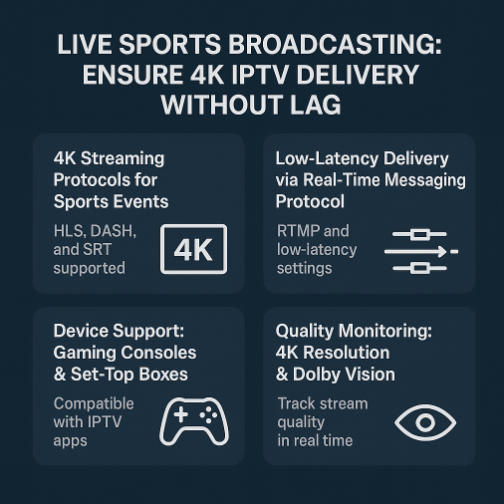
Let’s be honest: viewers don't tolerate buffering or pixelation—especially during a last-minute goal.
HLS and DASH are the go-to protocols for UHD delivery. They're great for adaptive streaming, keeping quality up and buffering down. Apple Developerdashif.org
SRT is catching on for secure, high-performance video over unpredictable networks.
Most top-tier IPTV providers now include support for 4K streaming by default.
Sports fans expect ultra-high-definition (UHD) with stable frame rates—and wholesale clients know it's a deal-breaker.
4K support is now the ticket to play—not the trophy.
Low-Latency Delivery via Real-Time Messaging Protocol
Quick, smooth delivery makes or breaks live sports streaming.
RTMP remains widely used on the ingest side and can minimize delay for live workflows.
It's built for real-time delivery with persistent connections supporting low latency.
Clients streaming to thousands (like bars or sports clubs) can’t afford sync issues across devices.
Paired with low-latency settings, RTMP ensures everyone sees the goal at the same time.
Bonus: It’s compatible with most live streaming infrastructures already in use.
This protocol doesn’t just deliver content—it delivers it when it matters.
Device Support: Gaming Consoles & Set-Top Boxes
Compatibility isn't just technical—it's strategic.
Set-top boxes are still king in commercial IPTV setups. They're easy to deploy in large volumes.
Gaming consoles, like Xbox or PlayStation, double as powerful media players.
Wholesale buyers love devices that offer broad compatibility with IPTV apps.
For guest-facing industries (hotels, gyms), Smart TVs with built-in support reduce hardware costs.
Providers who certify device support are the ones who win enterprise contracts.
Get the hardware equation wrong, and everything else falls apart.
Quality Monitoring: 4K Resolution & Dolby Vision
Delivering high quality is one thing. Keeping it consistent is another.
4K resolution isn’t just sharper—it’s expected in premium sports packages.
Dolby Vision brings vibrant color contrast, boosting visual fidelity and customer wow-factor.
IPTV services now include monitoring tools to track stream quality in real-time.
Common metrics include frame rate consistency, HDR signal integrity, and end-device decoding success.
Whether on a 100” sports bar screen or a 6” phone, quality assurance must be rock solid.
Good visuals aren't negotiable anymore—they're the business card of your service.
Conclusion
After reading this guide, you’re no longer shooting in the dark when it comes to IPTV services. You’ve seen how pricing, features, compliance, and tech all tie together—kinda like assembling the right crew for a big job. If you're buying in bulk, choosing the wrong provider can cost more than just cash—it could hurt your rep.
So don’t rush it. Think about your audience, your devices, and your content needs. The best IPTV setup isn’t always the flashiest—it’s the one that works hard and works smart.
What makes the best IPTV provider suitable for bulk buyers?
A wide range of content like sports and news
Easy use on Smart TVs and Android Boxes
High-quality streaming like 4K and HDR
Features like Cloud DVR and multi-screen support
Flexible pricing and reliable service
How is IPTV different from traditional broadcasting?
IPTV sends content over the internet using streaming protocols, while cable and satellite rely on physical wires or dishes. It’s more flexible and easier to update.
What features define the best IPTV packages in 2025?
On-demand shows and movies
An easy-to-use program guide
Catch-up for missed content
Streaming on phones and tablets
Parental controls and offline viewing
Are premium IPTV tiers worth the extra cost?
If you're offering services to hotels or public spaces, premium plans with better video quality and more features are often worth it.
How do North American regulations impact IPTV services?
U.S. rules around content rights and licenses
Canada’s rules for local content
Secure protocols like TCP and DASH are often required
Which devices are most compatible with IPTV for commercial use?
Smart TVs, Fire TV Sticks, and Android Boxes are great for businesses. They’re affordable and easy for staff or customers to use.
What is the best IPTV plan for live sports streaming?
4K quality for sports events
Low delay using RTMP
Support for gaming consoles and set-top boxes
Great color and brightness with Dolby Vision
How is streaming quality kept smooth on different devices?
IPTV adjusts the video depending on your connection. That’s why it works well on everything from smartphones to big screens.
What should wholesalers know about pricing IPTV packages?
Basic packages with HD and SD
Mid-range options with 720p and 1080p
Premium plans offering 4K and extras
Add-ons like catch-up or offline viewing
Why is the best IPTV service ideal for the hospitality industry?
Guests expect more now. IPTV gives hotels modern features like live sports in 4K and multi-language content that feels personal and easy to use.
